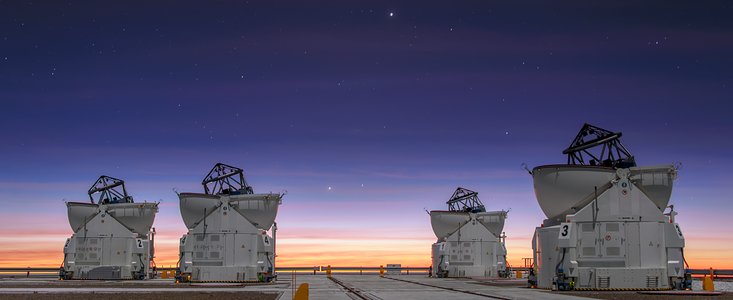Tiedote
NAOMI näki ensivalon
Uusi adaptiivisen optiikan huippumoduli ESO:n VLTI:lle
7. joulukuuta 2018
NAOMI (New Adaptive Optics Module for Interferometry) on saanut ensivalonsa, kun se asennettiin kaikkiin neljään ESO:n VLTI:n (Very Large Telescope Interferometer) 1.8-metriseen aputeleskooppiin Paranalin observatoriolla Chilessä. Esittelemällä huippuluokan adaptiivisen optiikan teknologiaa NAOMI on parantanut VLTI:n kuvantamisominaisuuksia ennennäkemättömiin mittoihin, antaen GRAVITY:n kaltaisille VLTI:n tehokkaille tieteellisille havaintolaitteille aikaisempaa kirkkaamman kuvan maailmankaikkeudesta.
VLTI on ESO:n VLT-teleskoopin (Very Large Telescope) tila, joka pystyy yhdistämään jopa kaikki neljä aputeleskooppia tai VLT:n 8.2-metristä yksikköteleskooppia muodostaen halkaisijaltaan jopa 130-metrisen virtuaaliteleskoopin, jonka avulla voidaan tehdä uskomattoman suuren erotuskyvyn havaintoja. Käyttäen VLTI:tä tähtitieteilijät voivat tutkia tähtien pintoja, aktiivisia galaksiytimiä, nuoria tähtiä ja valikoimaa muita kiehtovia tähtitieteellisiä kohteita.
Ilmakehän pyörteilyn VLTI:llä tehtäviin havaintoihin aiheuttamia vaikutuksia vastaan ESO on kehittänyt uuden adaptiivisen optiikan järjestelmän, jonka nimi on NAOMI. Järjestelmä rakennettiin parantamaan VLT:n aputeleskooppien herkkyyttä ja suorituskykyä yhdessä tutkimuslaitoksen Institut de Planétologie et d’Astrophysique de Grenoble (Centre National de la Recherche Scientifique/Université Grenoble Alpes) kanssa.
NAOMI:n kehitystyö oli suunnattoman haastava tekninen hanke. "Hiljattain asennettujen modulien tulee keskittää valo optisiin kuituihin, jotka ovat vain jokusia mikrometrejä leveitä — tuskin kymmenesosa ihmisen hiuksen paksuudesta!" selittää Jean-Philippe Berger IPAG:sta. "Kohtasimme myös merkittävän haasteen neljän adaptiivisen optiikan järjestelmän asentamisesta niin nopeasti kuin mahdollista, jotta emme häiritsisi VLTI:n havaintojen tekoa."
Aikaisemmin aputeleskoopit oli varustettu heikkotasoisemmilla STRAP-järjestelmillä (System for Tip/tilt Removal with Avalanche Photodiodes), jotka havaitsivat ilmakehän pyörteilyjen vaikutuksia ja korjasivat vastaanotettujen aaltorintamien kallistusta korjaamalla nopeasti ohjaavan peilin asentoa. Huolimatta hyvissä ilmakehän olosuhteissa tehdyistä ansiokkaista korjauksista, kuvanlaatu huononi huomattavasti olosuhteiden ollessa huonot.
"Havaitsemalla VLTI:llä aputeleskooppeja käyttäen riippui suuresti ilmakehän olosuhteista ja jokaisen auringonlaskun jälkeen odotimme malttamattomasti nähdäksemme olisiko nyt onnekas yö," selitti Julien Woillez, VLTI:n projektitiedemies. "NAOMI muuttaa kaiken tämän. Nyt me voimme havaita tehollisesti jopa huonommissa seeing-olosuhteissa."
Käyttäen kehittynyttä adaptiivisen optiikan järjestelmää [1] NAOMI parantaa VLTI:llä tehtävien mittausten tarkkuutta ja saavuttaa paremman ja vakaamman kuvanlaadun. VLTI:n veitsenterävä uusi adaptiivinen optiikka mahdollistaa tehokkaat, pitkät valotukset jopa huonon seeingin tapauksesa — tuoden esiin VLTI:n havaintolaitteiden parhaat puolet kaikissa ilmakehän olosuhteissa.
"Joinakin öinä näyttää siltä kuin ilmakehää ei olisi ensinkään! Me voimme nyt havaita paljon himmeämpiä kohteita," päättää Woillez. "NAOMI:n myötä me voimme nyt käyttää PIONIER:in, GRAVITY:n ja MATISSE:n kaltaisia huippuluokan, toisen sukupolven havaintolaitteita täydellä teholla."
Lisähuomiot
[1] NAOMI-modulin avainkomponentti on muovattava peili, jonka on valmistanut yritys ALPAO. Se on optisen insinööritaidon huippusaavutus. Peilin muotoa päivitetään 500 kertaa sekunnissa, minkä ansiosta VLTI:n näkökyky on lähes vapaa ilmakehän pyörteilyjen vaikutuksista.
Linkit
- Lisätietoja NAOMI:sta
- NAOMI:a esittelevä tekninen julkaisu
- NAOMI:n muovattavaa peiliä esittelevä tekninen julkaisu
Yhteystiedot
Rami Rekola
ESO:n tiedeviestintäverkoston Suomen edustaja
Tuorlan observatorio
Sähköposti: rareko@utu.fi
Calum Turner
ESO Assistant Public Information Officer
Garching bei München, Germany
Puh.: +49 89 3200 6655
Matkapuhelin: +49 151 1537 3591
Sähköposti: pio@eso.org
Tiedotteesta
| Tunnistus: | ann18089 |


